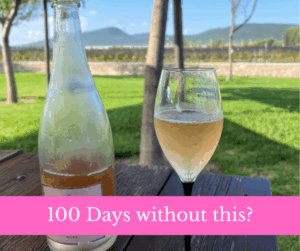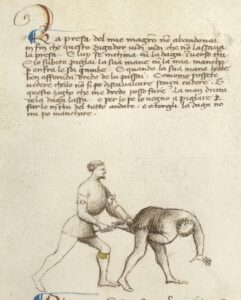
As I posted on Sword People last week, I'm taking 100 days off alcohol. Why would I do that?
The DEXA Scan: an uncomfortable truth
I was in London a couple of weeks ago for a family reunion, and took the opportunity to wiggle along for another DEXA scan (at BodyScan UK). My last was a year ago. On the positive side, I’ve put on about 2.4kg of ‘lean mass’ (the scan can identify fat, bone, and ‘lean mass’, which is everything that isn't fat or bone), mostly in the upper torso. And my overall fat percentage has come down from 24.8% in May 2024, to 21.5% now. Great.
But my genetics put the remaining fat mostly in my viscera, the absolutely worst place to have it. I had 148
cm² (which is a weird way to measure a volume, but hey) in May '24, down to 115cm² in August '24, but as the muscle piled on (yay!) it brought some fat with it (as it almost always does), and it all went round my organs, so it's back up to 136cm². Boo.

Subcutaneous fat isn’t such a big health problem, in reasonable amounts. But visceral fat is bad for inflammation, blood lipids, diabetes risk, the works. And it seems that’s where I store it.
I've uploaded the results as a pdf here, in case you're interested in the actual numbers: Guy_Windsor_DEXA_2025-08-13-report
So why cut alcohol specifically?
I’m not a big believer in calorie restriction as the main driver of fat loss, because while the laws of thermodynamics are absolute, your body is insanely complicated, and has all sorts of ways of adjusting your metabolism to lose or put on weight depending on various triggers. What you eat, and when, is as important as how much. And don't get me started on gut biome. I first really understood this when I accidentally lost 10kg in three weeks. But if there are a bunch of unnecessary calories coming in from somewhere, that's the obvious place to start.
For me the biggest source by far of “empty” calories is alcohol. My natural state is to have a glass of wine or two while cooking, and another glass or three while having dinner, and maybe a dram afterwards, pretty much every day. I normally get through about 7 bottles of wine a week minimum, without hangovers or other obvious ill effects. I think my soul is mostly Italian!
When I went alcohol-free for a month this Spring (thanks to a bad cholesterol test), I lost about 2kg and 4cm around my waist. It messed with other things though- I didn’t get a word written in all that time, other than newsletters. And I didn’t feel any particular energy benefits. Though I ought to have been sleeping better, I wasn’t waking up full of beans and ready to face the day any more so than usual.
But, several credible sources (the folk I listen to most on these subjects are Dr. Peter Attia, and Dr. Rhonda Patrick) suggest that the real benefits to cutting booze come around the three month mark. Kevin at BodyScan said the same thing. So I’ve decided to take 100 days off alcohol. I started on August 19th. Day 100 is November 26th, four days before my birthday.
Why not just cut back?
It's very hard to measure a small amount every now and then. Sure, I bet I could get most of the benefits if I just had one glass of wine on a Friday night. I've previously established with sleep monitors that a glass of wine with dinner has no measurable effect on my sleep (I eat early). But then what happens to the rest of the bottle? How much wine is that really? What if I swapped out the wine for a dram of Lagavulin? It's just much easier to measure “no booze” than figure out “some booze”. And from a self-control issue, it takes very little effort (for me) to have decided to not drink at all, than to stop at one. The hard part is making the decision to stop. Now that's done, thanks to bastard DEXA, it's really no big deal (for me).
I know that other people have much more serious issues with alcoholism or other addictions, so please don't read this as minimising their struggles. And I can think of several life events that could occur that would lead to me immediately abandoning this experiment in favour of getting blootered. So no judgement.
The Pros and Cons of alcohol restriction
You may find the pro/con analysis I do for any intervention a useful rule of thumb, so here goes.
Cons first (always):
1. Is there any known, or likely, health downside? If someone were to suggest going without vegetables for 100 days, or going without protein, or going without exercise, or without in-person social interaction, I’d want to see an awful lot of peer-reviewed studies suggesting that it was a good idea. But there is no known health benefit (that actually stands up to scrutiny) of consuming alcohol. So I won’t be sacrificing any useful nutrients. The polyphenols in wine? I get way more of them from blueberries and dark chocolate.
2. The most common downsides of any intervention are time and money. Exercise costs time. Supplements cost money. Cutting out alcohol saves money and takes no time.
3. Alcohol has been a major component of Western culture since at ancient times. The slaves that built the pyramids were fed a kind of beer. 2600 years later Jesus's first miracle was turning water into wine. 2000 years on, not much has changed. Just about every major event is marked with booze of some kind. We drink with friends, we drink to celebrate success, to commiserate in disaster, to raise a toast or to drown a sorrow. Wine, beer, spirits of every kind have been part of our culture (and many others) since forever, and there is a huge amount of artistry that goes into creating a perfect wine to go with your steak, or the smokiest of single malts. That's the only thing that makes this in any way difficult: the sheer number of times already (it's been less than a fortnight!) when I've had to risk being thought anti-social to decline an offered drink. People who like to drink (like me!) can take this as a critique of their current habits. Nothing could be further from the truth. But cutting out alcohol does carry a social risk.
I worked out that the last time I went 100 days with no booze I was 13. It’s been nearly 40 years since I last tried this, and it’s just an experiment, not a moral position.
So the worst-case scenario is I get no noticeable benefit (but save some money), and lose out on some gustatory delight, and some people will find me stand-offish. I can live with that, for SCIENCE. I don't judge other people by what they choose to drink, so have no interest in the judgements of those that do.
Pros:
1. There is good reason to suppose that I’ll cut the visceral fat down, because it’s happened before (between my first two DEXA scans, in May and August 2024 which established a clear correlation between waist size and visceral fat quantity), and because of the waist reduction this year, in just 33 days of no alcohol.
2. There ought to be improvements in sleep quality. This is very hard to measure, and regular readers will know that I’ve tried several different sleep trackers and found problems with all of them. The only metric that seems at all reliable is heart rate. With alcohol, my heart rate is higher and more erratic when sleeping; without it, it’s lower and steadier. I've confirmed this many times since getting my first sleep tracker in 2017.
3. It’s a clear break from a habit I know is not healthy, and a fairer test of sobriety. I wouldn’t necessarily judge the effects of a diet or exercise program after just a month, so it seems reasonable to give no booze a fair crack of the whip.
The best case scenario is that I get amazing health and vitality benefits from this. But that will raise the issue of do I go back or not? I’ll have to entirely re-think the place that alcohol plays in my way of life. So I’d be lying if I said I wasn’t kind of hoping that it doesn’t help much.
It’s important to keep any test to just one variable. If I replaced booze with doughnuts I could reasonably expect to not lose any visceral fat. So I’m giving myself a couple of weeks to let my usual dietary rules slip a bit (I had four slices of my daughter’s banana bread after dinner last Sunday, with marmalade) but once I’m back from Swords of the Renaissance this weekend I’ll be pretty careful about keeping the rest of my diet as it was.
And finally…
I intend to report back here (maybe even with another DEXA scan) in due course. But I keep my friends on Sword People, and my newsletter subscribers updated on all sorts of things, including my various health experiments. Join us there, or sign up for the newsletter (or both!).
And let me just re-iterate: I'm running a health experiment. I have no moral problem with alcohol, and I don't think of myself as an alcoholic. If alcohol is damaging your health, or getting in the way of your goals, feel free to try 100 days off, or better yet get professional help. But it says nothing about your moral worth whether you drink or not.
Update at 50 Days
50 days into this experiment: so far, so good. The hard part was making the decision. Once it was decided, not drinking is normal. There are open bottles of booze in the house, but no temptation. Every now and then I fancy a drink, but the urge passes quickly. This was as true on day 1 as it is on day 50.
The closest thing to an exception has been a couple of social events in pubs, where I had a low-alcohol (0.5% or lower ABV) beer. I’ve done that twice. I don’t think it matters particularly, but I’ve decided to be careful in the last 50 days to stay off even that.
My weight is down about a kilo and a half (3.5lb), and my waist is down about 2cm. These are averages: weight fluctuates a lot during the day and from day to day: have a glass of water and you gain half a pound or so. Eat more fibre the day before and there’s more water held in your gut. So I measure weight and waist every day, and average them up over the week. Waist is especially problematic to measure, as it’s me with a tape measure, trying to be consistent about exactly where on my body I’m putting it, and exactly how tight, at what point in my breathing cycle. Sucking in my gut gets me down to 84, expanding as much as possible gets me to 96 (which is significantly smaller than my relaxed measurement in May 2024). So I’m not treating these figures as hard or accurate, but they are a reasonable guide to progress.
The oddest thing about this is that all of the weight and waist gains occurred in the first 25 days; they have been basically stable since then. Though I suppose it’s possible I’ve been losing fat and gaining muscle (or the other way round) since then. My weight training is the most reliable guide to muscle mass until the next DEXA scan, and I’m getting gradually stronger (as one would expect), so I doubt I’m losing significant muscle mass. I’m also careful to keep my protein intake quite high (about 1.5g/1kg of body mass, so about 120g/day for me).
I’m not sure if I’m sleeping better or not. I don’t wake up feeling any more rested than I did before, but I have several times slept a lot longer than I used to, for no apparent reason. I’m hoping that my brain is adapting to the lack of booze and getting better at staying asleep, but it’s too early to tell. Sleeping longer means I’m waking up later, so my usual habit of getting an hour or so of writing in before the house wakes up isn’t happening, but that’s ok; I seem to be productive enough.
On balance, this has been underwhelming in terms of health gains so far. I was expecting significantly more benefits already, given that I’ve come down from drinking an average of a whole bottle of wine every day. But who knows, maybe the next 50 days will hold some surprises.
This experiment is an example of my overall guiding principle of training: figure out what works for you, then do that. Both of those aspects are challenging: how do you figure out what works for you? And how do you maintain the practice of applying it? I go over all these things and more in The Principles and Practices of Solo Training.










